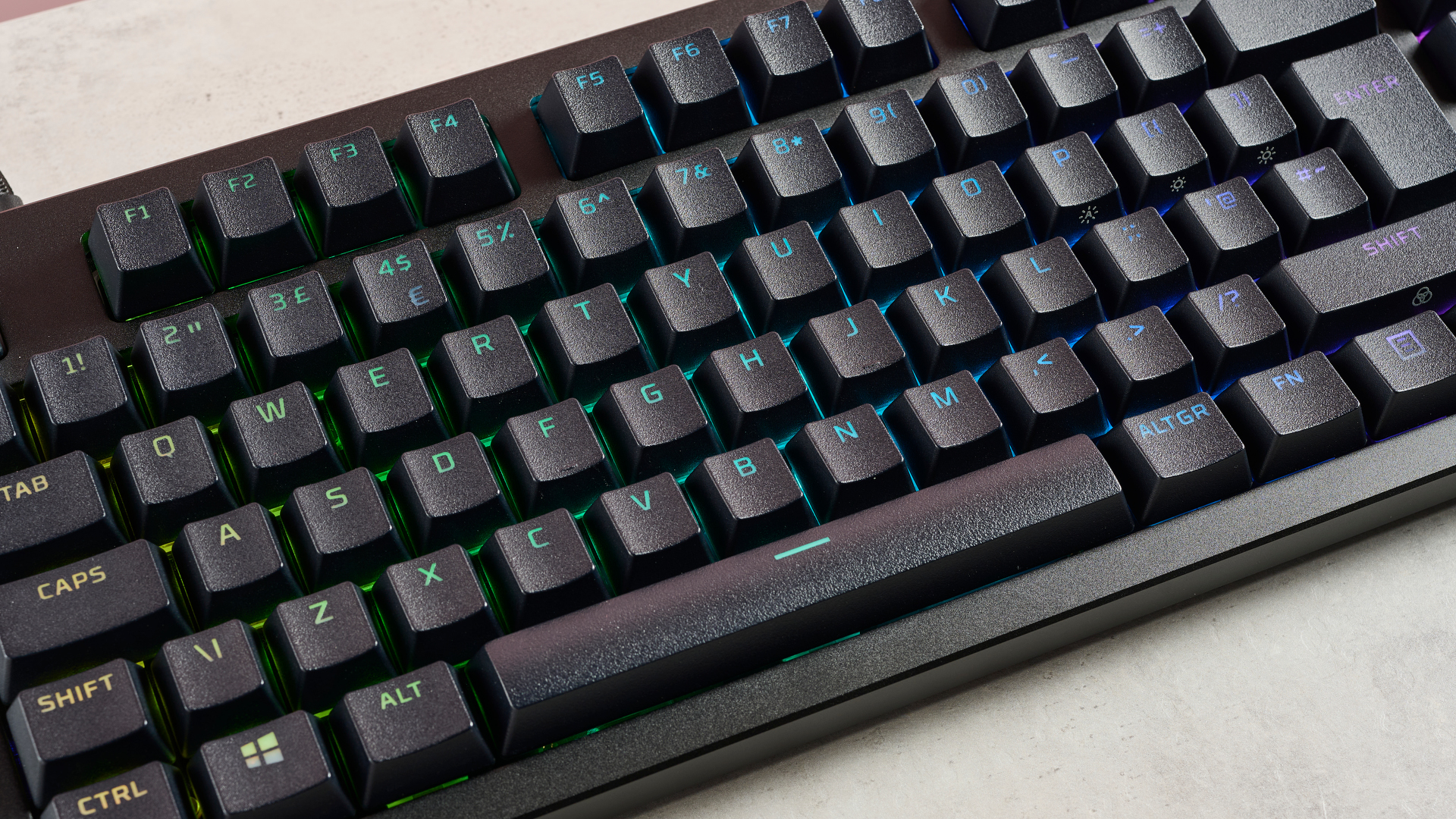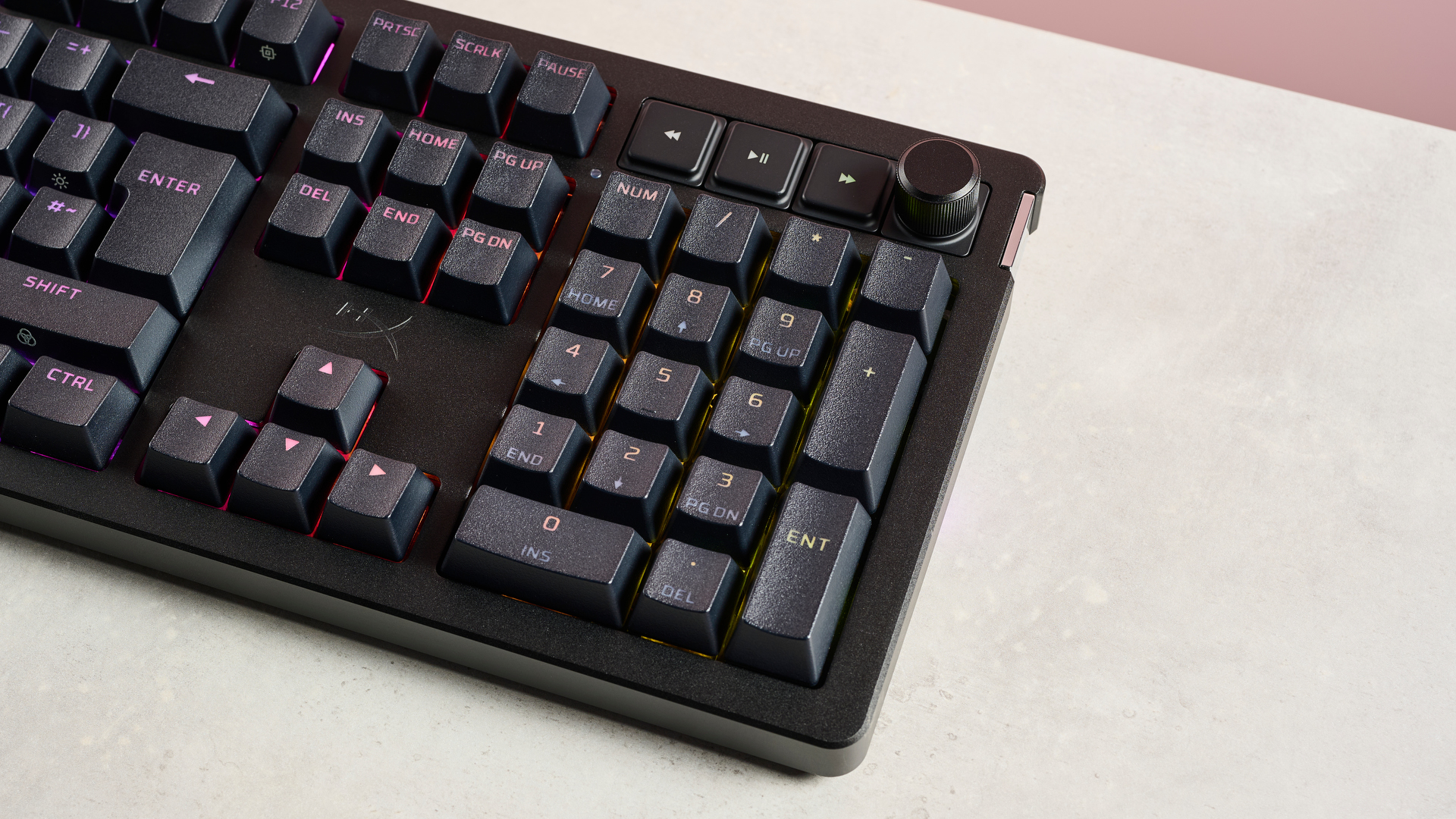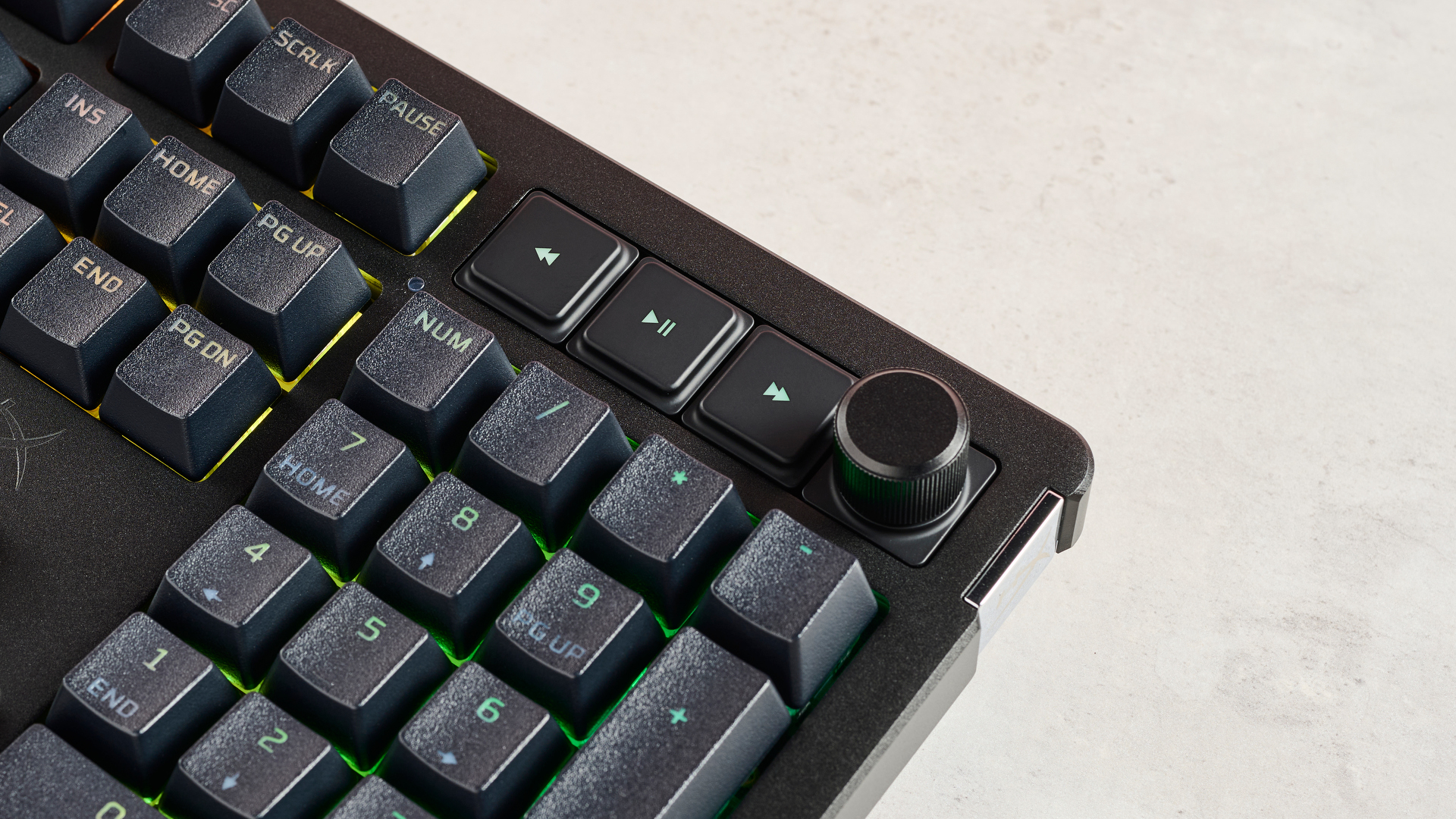HyperX Alloy Rise review: a lightning performance keyboard with weak software
HyperX Alloy Rise: one-minute review
The HyperX Alloy Rise sits at the top end of the brand’s gaming keyboard range, claiming to be a strong and fast mechanical board for ultimate performance.
At first glance, the Alloy Rise doesn’t look much like a gaming-oriented peripheral, especially compared to some of the best gaming keyboards around. It only comes in one color, black, and the stylings typical of this market are largely absent. There are a few nods to its target audience, such as RGB backlighting and personalization opportunities, but on the whole, the design of the Alloy Rise is fairly anonymous, which isn’t usually a charge one can level at gaming gear.
It’s also a very substantial piece of hardware, weighing in at 1.3kg. Although the key layout is compact, the chassis is quite thick, which reveals one of the worst design flaws of the Alloy Rise: its lack of wrist support. The elevated height forced my wrists to bend upwards at an uncomfortable angle and put too much pressure on the heels of my palms. Propping up the back feet did help somewhat, but not enough to alleviate the discomfort altogether. What’s really needed here is a wrist rest but, unfortunately, the Alloy Rise doesn’t come with one.
As you would expect from a premium gaming keyboard, the keycaps are made from PBT. They are mildly textured, offering enough grip while still retaining a smooth feel. The default switches underlying them are HyperX’s Red Linear variety, which actuate very quickly with light touches, making them great for fast-paced gaming sessions. However, I found that misinputs were an issue for me, especially when typing. I did acclimatize eventually, but if you’re used to traditional mechanical boards, this might not be an issue for you.
The compact layout makes adopting the WASD position comfortable, with all the important keys easily accessible. The always-awkward Ctrl key is much easier to reach for compared to other boards I’ve used, and the weight and thock of the space bar is a real highlight (although my thumb did tend to hit the back edge of the bar if I didn’t use a wrist rest).

Less of a highlight is HyperX’s take on peripheral software. Ngenuity, as it’s called, lets you rebind every key, offering options for primary and secondary functions, but there are far fewer system-level shortcuts available compared to other manufacturers’ software. It does feature a macro recorder, though. You can also customize the backlighting with different colors and effects, and even sync them with other HyperX devices you have.
Considering where the Alloy Rise stands in its lineup, HyperX seems keen to pitch it as a top-tier gaming keyboard. Based on its feel and performance, it’s nailed that aspect, but the lack of wrist support, in-depth customization software, and wireless capabilities prevent it from being a true standout.
This is a hotly contested market, and there are equally capable boards out there for a similar price or less, including plenty of offerings from big hitters such as Razer, Logitech, and the like.
HyperX Alloy Rise review: price and availability
- $199 / £169 / AU$308
- 75% model available for less
- One colorway
The Alloy Rise is priced more or less in line with other premium wired gaming keyboards. There are certainly costlier options out there, such as the Razer Huntsman v2 Analog, but there are also plenty at a similar if not cheaper price point.
HyperX offers some optional extras for the Alloy Rise, including a variety of keycaps, switches, top plates, side badges, and wrist rests. There’s also a 75% variant available, which costs $169 / £149 / AU$277.
If you’re after a full-size board, then the Asus Rog Strix Scope II RX is another option for a cheaper price ($139 / £149 / about AU$210). It uses optical mechanical switches that are also quick and precise. However, the Asus Armory software isn’t up to the same standards as its competitors. It does come with a wrist rest, though.
There are some wireless options available for a similar price, too. The Corsair K65 Wireless is a similar gaming keyboard with a price of $159 / £149 / about AU$250, but it's 75% rather than full size.
Value: 3 / 5
HyperX Alloy Rise review: specs

HyperX Alloy Rise review: design and features
- Solid construction
- Nondescript looks
- Uncomfortable on wrists
The HyperX Alloy Rise is fairly restrained and understated, as far as gaming peripherals go. Naturally, there’s some RGB lighting to liven up proceedings, but branding is kept to a minimum. The company logo only appears in the faint indentation above the arrow keys and on a small side badge; the latter is attached magnetically and can be swapped out for others sold by HyperX.
Aside from these accouterments, there’s very little to distinguish the Alloy Rise from any other workaday keyboard. Some may prefer this level of anonymity, and to my mind, it certainly beats the garish designs many brands adopt in their bid to appeal to gamers.
That said, there are some aesthetic customization options for the Alloy Rise. Like the aforementioned side badge, the top cover is also magnetically attached and can be swapped out for another design made by HyperX. The keycaps can be replaced too (as well as the underlying switches), and while HyperX claims the same is true of the rotary knob, I couldn’t find any replacement examples on its website.
As for the form factor, the Alloy Rise has a substantial depth, but the full-size version has a surprisingly compact layout. One of the major drawbacks of this board, though, is the lack of wrist support. Due to the thick chassis, the keys sit high above the surface, which forced my wrists to bend to an uncomfortable degree and placed too much pressure on the heels of my palms. The back feet help to alleviate the problem somewhat, but not enough to solve the issue completely.
The full-size model I was given to test comes replete with three extra media keys, nestled in the top-right corner above the number pad. Disappointingly, they feel cheap and out of place compared to the rest of the board. However, the rotary knob, which is available on both keyboard size variants and controls the volume, feels nicely notched for smooth yet precise dials. Pressing it also mutes the audio.

Ngenuity, the peripheral software HyperX provides, has some customization options, including the ability to set primary functions for every key on the board (and secondary ones for most of them too). It even includes a macro recorder. However, there is a distinct lack of media and system-level operations to choose from, and, disappointingly, you can’t change the function of the rotary knob, which could’ve potentially been useful for making other scrolling-based adjustments, such as switching tabs in a browser and the like.
Setting up the RGB backlighting in Ngenuity is a modular process, giving you the ability to add effects from a predefined list, with several to choose from. You can also sync your lighting preferences between compatible HyperX devices. How much mileage you’ll get out of this depends on how you feel about RGB light shows, but the range of options should satisfy those who are keen on them.
Design & features: 3 / 5
HyperX Alloy Rise review: performance
- Super-fast keys
- Great for WASD position
- Easy to mispress
The Alloy Rise features lightly textured PBT keycaps, making for a smooth feel with sufficient tactility. The stock switches on the Alloy Rise are HyperX’s own Red Linear switches, which actuate with the lightest of touches and rebound very quickly.
This helps to make typing sharper, but I found them to be a double-edged sword: presses are instantaneous, but misfires are all too easy. For those who are used to this level of sensitivity, though, it might not be a problem at all, and I found that I did acclimatize fairly quickly. Another aspect that makes typing a little trickier is that the bumps on the F and J keys aren’t very pronounced, so locating them when touch typing isn’t always easy.
The stock keys aren’t as deep as those on other mechanical boards, which aligns with my preference for shallower keys I can glide over. While they aren’t what you’d call low profile, their short actuation means you don’t have to press very far at all, making typing easier for me compared to other mechanical keyboards I’ve used.

Key presses emit the typical mechanical thock, if sounding a little hollower than usual. Coupled with the generous lubrication, this helps to make the Alloy Rise quieter than many of its peers, while still providing enough gratifying feedback.
For gaming, the short travel and sensitive keys are great, although as with typing, I found that I had to be mindful of accidental presses, so this may take some getting used to if you’re coming from less sensitive switch types.
Adopting the WASD position is comfortable, with all the essential gaming keys within easy reach, particularly the Ctrl key, which I often find uncomfortable to hit. The space bar is a joy to mash with your thumb, but only when used with a wrist rest and the back feet raised, otherwise you’re more likely to hit the back edge rather than the top.
Performance: 4 / 5
Should I buy the HyperX Alloy Rise?
Buy it if…
You want to be fast
The proprietary Red Linear switches made by HyperX are very fast and easy to actuate, making for quickfire strokes.
You want to customize your hardware
The keys and switches can be swapped out on the Alloy Rise, as can the magnetic face plate and side badge for added personalization, although this is quite limited.
You want to use it with consoles
In addition to Windows PCs, the Alloy Rise is compatible with PS5, PS4, Xbox Series X|S, and Xbox One. Unfortunately, there is no macOS support.
Don’t buy it if…
You have wrist pain
There is no wrist rest with the Alloy Rise, and it sorely needs one, as the thick chassis creates an uncomfortable angle, and the fold-out feet aren’t enough to resolve the issue.
You want the best peripheral software
Although HyperX has its own peripheral software, Ngenuity, it doesn’t offer much in the way of customization, with limited functionality compared to some of its rivals.
You want to go wireless
The Alloy Rise isn’t wireless, which is a shame considering there are now plenty of great wireless gaming boards out there for the same price or even less.
Also consider
How I tested the HyperX Alloy Rise
- Tested for two weeks
- Used for gaming and productivity
- 10+ years of PC gaming experience
I tested the Alloy Rise for around two weeks. I used it for gaming, playing fast-paced FPS games such as Selaco and others. I also used it for work and general productivity, which included plenty of typing.
I have been PC gaming for over 10 years and have experience with a wide range of keyboards, including mechanical and membrane, wired and wireless, all with varying switch types and keycaps.
- First reviewed July 2024
0 comments:
Post a Comment